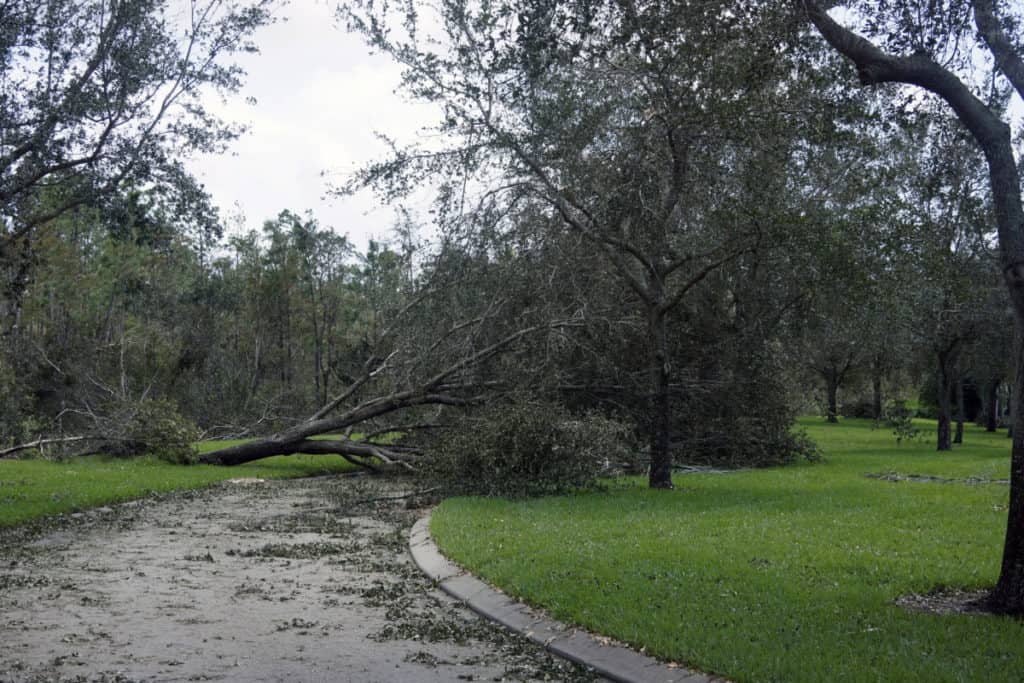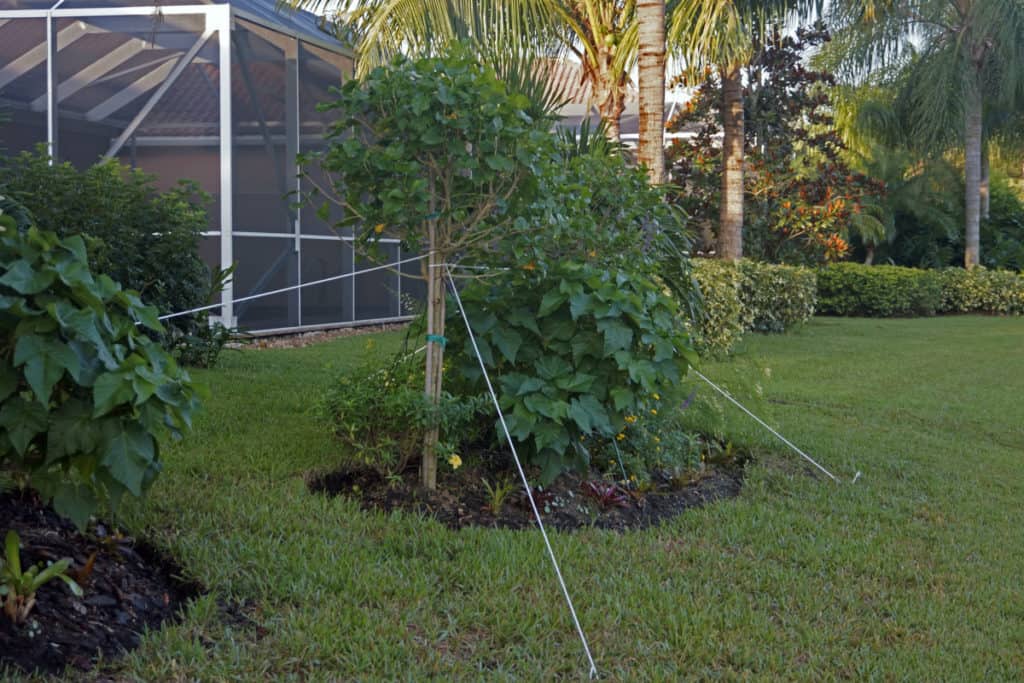Hurricane season starts June 1, and we should expect to be at risk for damage around the house until November 30. Here is how to hurricane-proof your Florida yard and garden.
Avoiding the worst efforts of Hurricanes – the summer visitors who have only first names and come in alphabetical order – starts with the first shovel we put in the ground, but it’s never too late. Here is how to hurricane-proof your Florida yard and garden.
Download My Free Hurricane Ready Checklist
It has all the steps you need to be ready when the big ones come.


Long Before Hurricane Season: Regular Care Pays Off
Here in sunny Florida, we listen to our dermatologists- they tell us that the sun damage we notice today was done half a lifetime before-at least! We have learned preventative maintenance for ourselves.
The flying debris and fallen trees we see after a storm also often have roots in decisions we made long ago.

Take These Steps
Trees
Right Tree Right Place – Plant for maturity. Larger trees and invasive roots need to be away from the house, power lines, and other structures.
Wind Resistant Species- In Florida, especially following Irma, we saw that native trees and those from typhoon areas of the world did best. Native plants tend to be wind and salt-resistant. It’s a good idea to notice the microclimates in our yards. For example, we live on a pond; wind can build up across it, and trees facing it can experience more movement than other trees.
Examples of Tree Varieties– Gumbo Limbo, Live Oak, and Smaller Palms have good resistance to wind.
Buy Healthy Trees– bare root seedlings should have moist and fibrous roots. Deciduous seedlings should have roots about equal to their stem length. Balled roots should be firm to the touch, especially near the trunk. For trees in pots, avoid those with large circling roots. They’ve been in that pot too long! Pruned roots should be cut cleanly, none wider than a finger. Soil and roots should be joined tightly.
Plant Trees in Groups groups of trees improve wind resistance; the mass of trees will protect each other and the rest of the garden from damage.
Practice Regular Pruning and Maintenance – don’t wait for that storm. Prune on a regular schedule, support healthy growth, and remove diseased or weak growth. Group trees together wherever that fits your plan. Trees together buffer each other – and the rest of the landscape – from winds.
Trim Judiciously – Evaluate each tree for damaged or dying branches. Learn the needs of each species. Palm fronds, for example, are reservoirs of Potassium. Leave the green ones on the tree to feed it. Look at your palm trees and imagine a clock face on top. Don’t trim higher than 9 and 3, and you’ll avoid starving the tree.
In The Garden
Fertilizer – Keep a regular schedule. Delay a scheduled treatment when heavy rain is expected. Better to delay it than waste it and put it in the water systems.
Put a 10-cent Plant in a $5.00 Hole – This pithy advice came from Ralph Snodsmith, a New York gardener you may remember from morning TV, but it works everywhere. Follow the planting instructions as to hole size and depth. Make it big enough and deep enough. I have cheated on this at the end of a long day and had to look at my mistake every day after that.
When Normal Rains Come – check around the yard about 5 hours after any good rain. If there is still standing water by that time, you might consider improving the drainage. A little problem and some damaged turf after rain becomes a big one in storm season.
Before Hurricane Season Starts
Check on Plants and Trees- Inspect for these four things:
- Healthy Bark
- Leaning
- Broken Branches
- Rubbing Branches
Staked Trees – ensure any tie-downs are firmly placed; they can become projectiles.

Look Over Decorative Elements and Potted Plants – Plan ahead for those that will need to come inside or be moved when the storm warning comes. At that point, time passes quickly.
Before the Storm
Keep Storm Drains Clean – If you stay home for the duration of the storm, watching the water rise is less traumatic when you know the water you see has a place to go. Clean gutters to keep water away from the house. If there are no gutters, using pavers under runoff areas may be helpful. Open the rain barrels if you have them.
Irrigation Systems – When the storm is imminent, turn off the irrigation systems. High winds and saturated roots lead to uprooted plants.
Palms – Remove any dead fronds, flowers, and fruits. These can be damaging projectiles.
Move the Potential Projectiles – some things can surprise you; flags, signs, wall art, furniture, planters, and hanging baskets. A sheltered corner or place where two fence lines join can be a safer place for potted plants. Alternatively, you can move pots inside during the storm or line them up beside the house.
Tall Potted Trees and Larger Potted Plants – should ride out the storm better if lying down on the ground.
Outdoor Orchids – In warm climates, orchids do well in trees. We see little damage to those which are well-established. Consider spraying with fungicide before the storm.
Learn Your Community Rules for Yard Waste Removal
After the Storm – as soon as it is safe to do so – Evaluate the Damage
Evaluate the Risks First – Before you start to work, look for problem areas, downed power lines, damaged trees and buildings, displaced creatures, and water where it doesn’t belong. Wear safe clothing, take pictures, refer to the last sentence of this article, and use them then.
Toppled trees and Shrubs – Pull these upright in their holes as soon as possible and cover the roots with soil. Our heavily planted community had more than 1000 downed trees after Hurricane Irma. Those we lost were primarily trees that crews simply couldn’t get to fast enough.
Basic Tasks – Clean the storm drains, remove any hazards if the ground is saturated, and remove mulch to let the soil dry. Cleaning up is important; creatures of all kinds are seeking higher ground near the house!
Put Back Your Favorite Garden Bench – and have your favorite garden beverage. You earned it!
References
The University of Florida performs extensive research on trees and their ability to survive hurricanes. You may find this interesting. Note that the first article will lead you to others.
